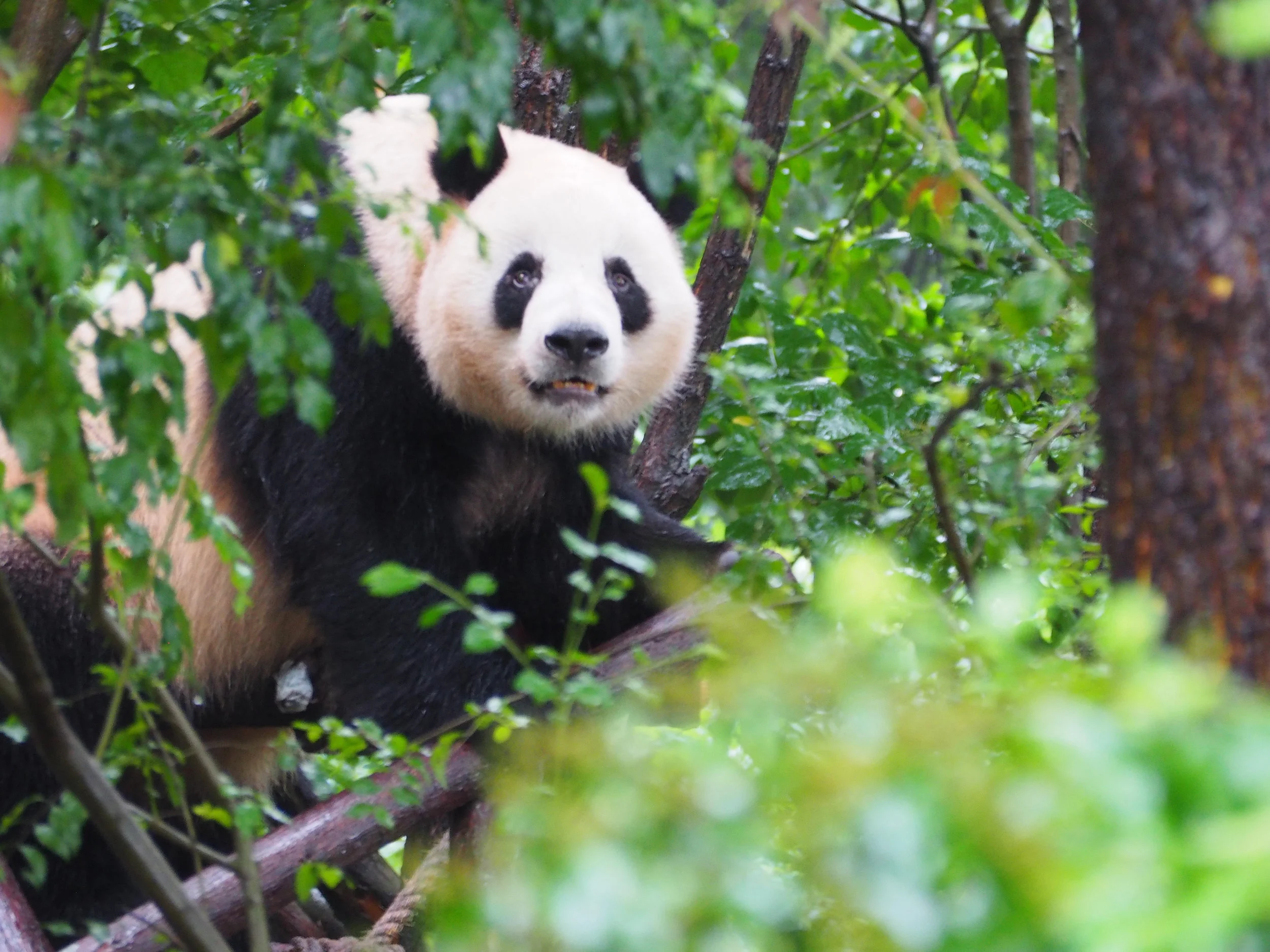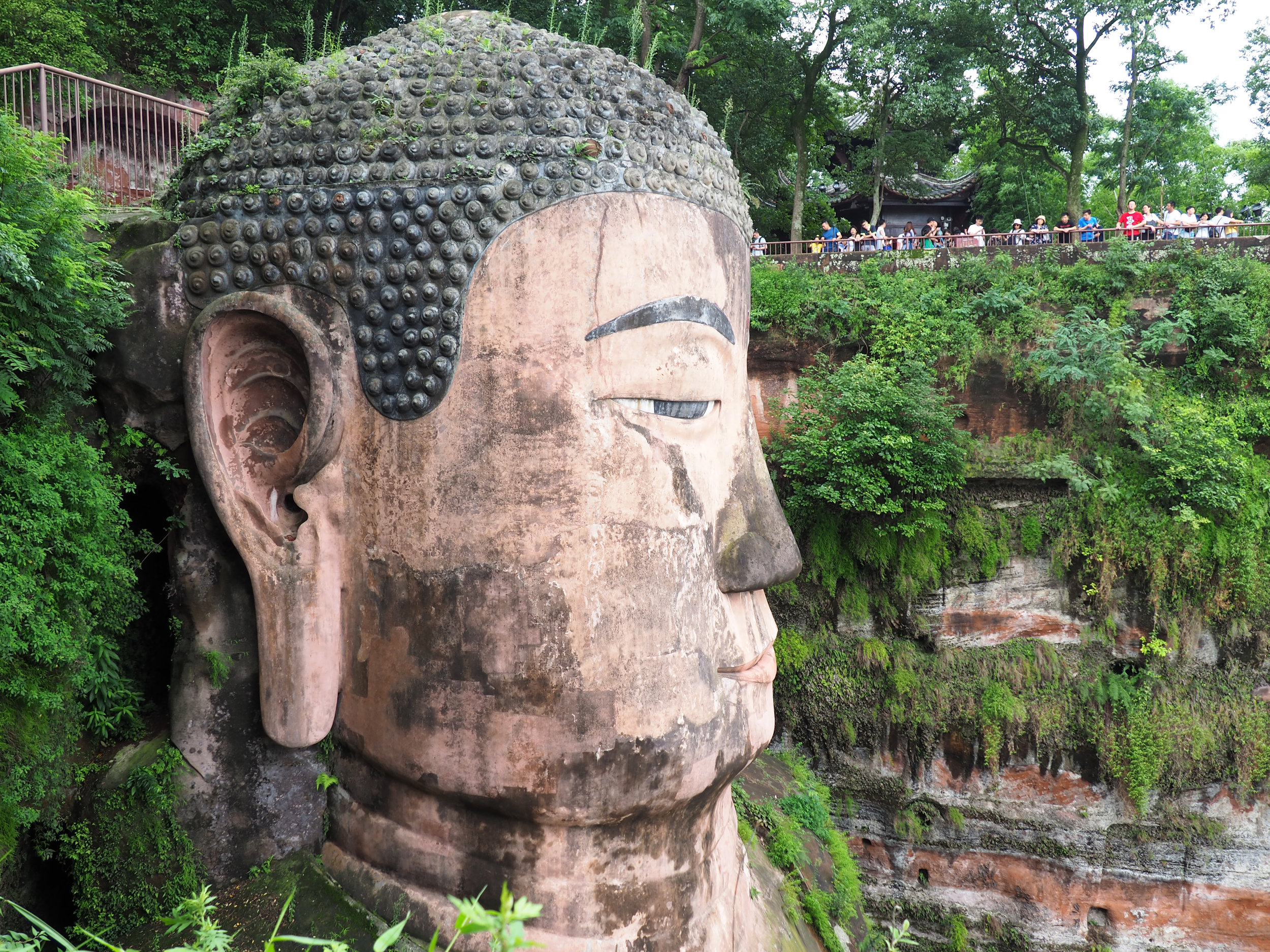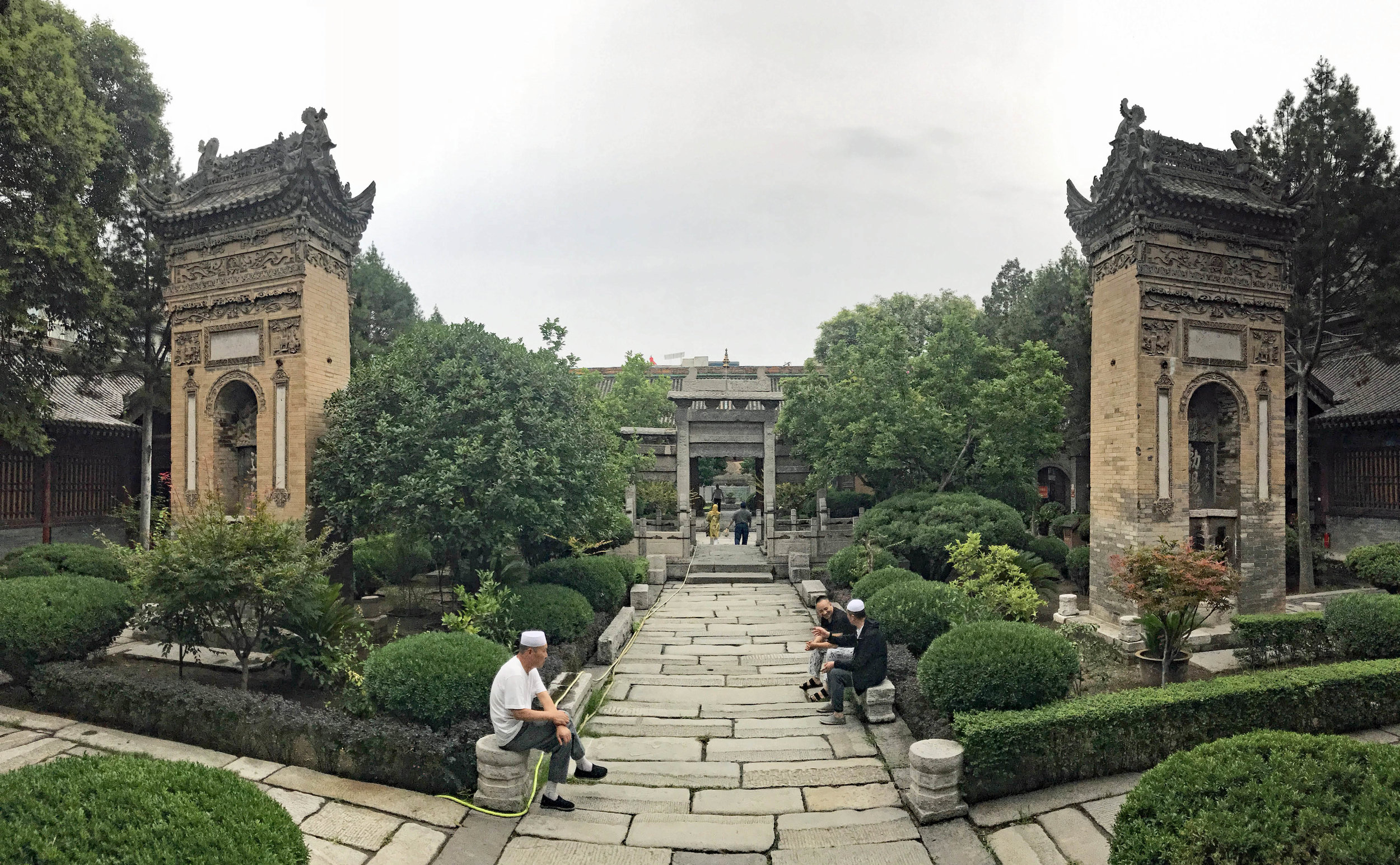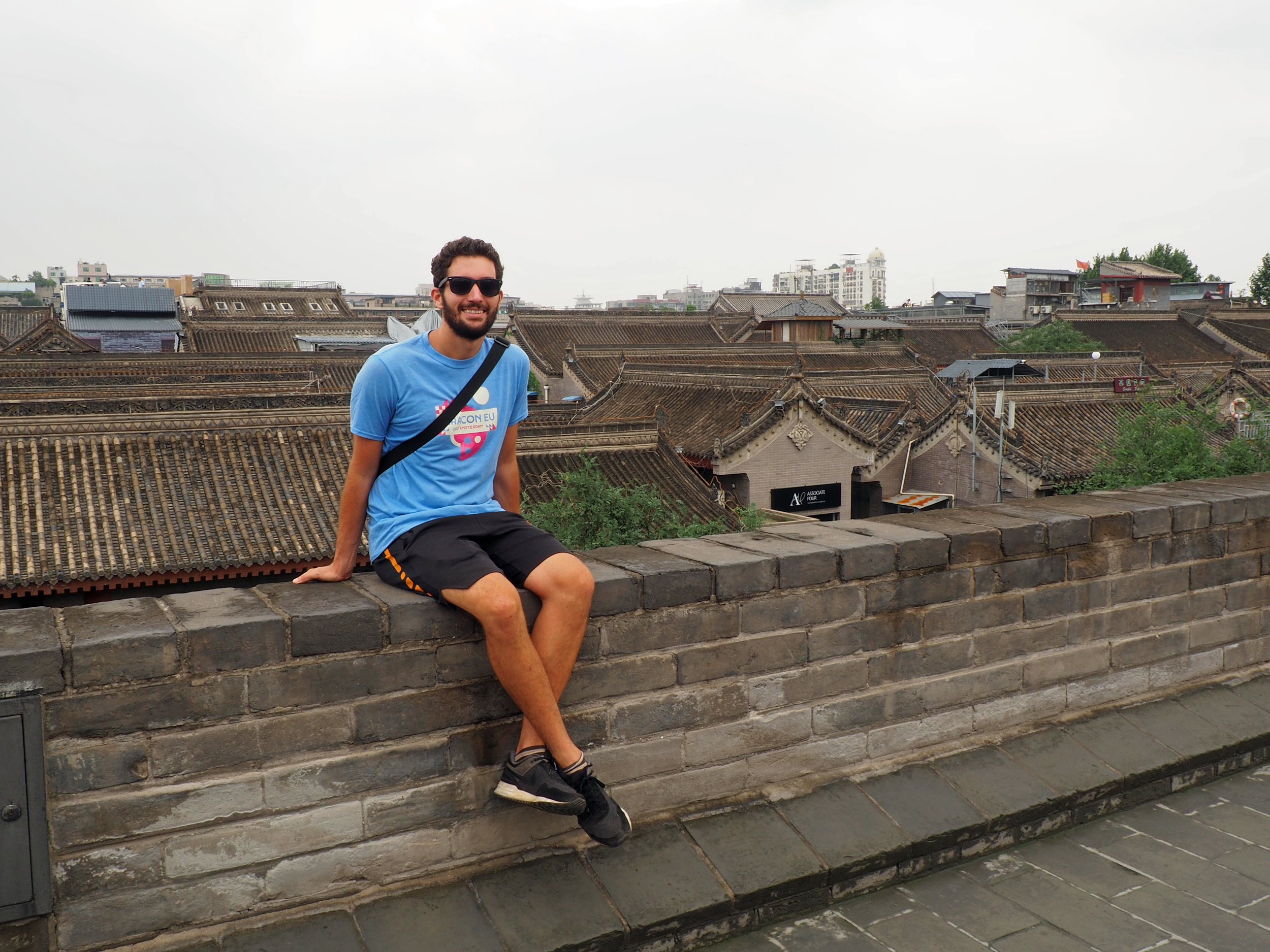Chengdu
With a restless night on an airplane and a surprisingly enjoyable morning layover in Singapore behind us, Stefje and I stepped off the plane into China once more. Low clouds threatened with rain, but the heavens didn’t open up until precisely the moment we stepped off the airport shuttle bus into Chengdu’s center district, forcing us to immediately seek cover.
July in the Sichuan province means the rainy season is in full swing; for the next 48 hours the weather would alternate between a light mist and a torrential downpour. Despite the murky weather, the wide streets, clean sidewalks, and relative calm was a godsend for our tired bodies after a solid month of hectic travel in India.
Our first day in Chengdu was one of trial and error and error. We showed up at the train station with hopes of buying a ticket to nearby Leshan to see the Big Buddha which resides there, but tremendously long queues to buy a ticket and a rush of weekend traffic meant there wasn’t an available train until 2pm.
Along with another American traveler from the hostel with the same itinerary, we opted to make our way to a lunch spot to kill time before the train. Unfortunately, we vastly overestimated the bureaucratic challenges of train stations in China.
On our way back into the station after lunch, we had to have our passports manually checked, go through security, and sprint across a station hall about half a kilometer long just to learn that they close the doors 5 minutes before departure, making us a minute too late! Utterly disappointed with the outcome, we had no choice but to wait in line for new tickets and observe the absurdities of scale only possible in a Chinese high speed rail station.
Amidst even heavier precipitation the following morning, Stefje and I made our way to the main tourist attraction in Chengdu, the giant panda breeding center. More than 120 of the adorable creatures live in the large nature park, which was overrun with both rainwater and people on a Monday morning.
We explored on foot, quickly getting our shoes and shirts soaked as we made our way to the “Sunshine Delivery House.” It was here that we got our first look at tiny baby pandas.
Ranging from pink newborns without their distinctive white and black fur to adolescents, the young pandas were all either sleeping or barely moving.
The youngest were lounging in surprisingly human settings: they cuddled in fluffy blankets and were warmed by the light of incubation units.
Further along we came to the enclosures where the adults are housed. Here we could glimpse the larger versions of the furry creatures in all their beauty. They munched on leaves and prowled the grounds with waddling gaits through the constant precipitation, enjoying large morning meals of bamboo.
With thick coats of pure white fur and dashing black outlines around their eyes, every time we caught a glimpse of one of the pandas head on it was a shocking sight.
Hordes of Chinese surrounded each animal, but at times they would grow bored with one and move on. Meanwhile I was content to just observe the large beasts heave for breath and sit in odd positions, using their short back legs for structural support or cuddle in the rain.
Eventually they would begin moving around again, using their onsite play pens, rumbling around in the grasses, and munching on everything in sight.
As a huge downpour came over us, I bolted inside to discover the highlight of the visit: a group of 5 young pandas eating together. They started by standing on their hind legs at the doors where the food would arrive, peering inside the barred windows with surprisingly nimble footwork.
Once the bamboo was spread out on the floor by the handlers, they sat in delight and ate away, each one eventually slowly falling to eat on their back like a cute yet sloppy child.
With the image of pandas firmly imprinted on our minds as the most adorable facet of China thus far, we were much more relaxed during the taxi, train, and bus rides which successfully led us to the Big Buddha.
Our first glimpse was simply of a huge head, which dwarfed all expectations and dominated over the surroundings. Humans were inconsequential next to a structure of this size.
Were peered down below our feet to uncover the Buddha’s body, which stretched down more than a hundred feet and was perfectly carved out of the red sandstone. By the time we made it to the bottom of a long staircase, it was with immense wonder that we stared upwards at this magical creation.
Xi'an
Chengdu's 3rd rainy morning in a row brought us from our hostel to the train station in a heavy fog. By the time the train cars started lurching away, we were happy to bid the bad weather goodbye. In the middle of the afternoon we arrived in Xi’an, a shocking 900 KMs (560 miles) from Chengdu. The layout of the high speed station and metro was identical, betraying the fact that we had covered a huge swath of the country.
Stefje and I spent the rest of the afternoon getting acquainted with the city, which may have peaked in global importance during its time as the terminus of the Silk Road in China, but retains local prominence as the capital of the Shaanxi province. For centuries on end, Xi’an was also the capital of China, which was at the time neck and neck with the Roman Empire for the most technologically advanced civilization in the world.
This long and storied history has differing side effects: whereas the city draws millions of visitors each year to sites of global archeological importance, the growing pains of the large metropolis are also further exacerbated every time subway line construction must be halted due to the discovery of another set of priceless artifacts.
Punctuating the historical importance is a city wall which is almost 1000 years old and has miraculously withstood the onslaught of development prominent in China. We passed through one of the many gates to find our guesthouse, then set off on foot to explore the city.
Just as I was beginning to assume that every last vestige of the historic center had been mutilated by the overwhelming consumerism of fast food restaurants and shops hawking worthless plastic souvenirs, my eyes peered upwards to discover the city’s drum tower. Positioned in a central circle, the large three story building shimmered above the chaos at street level to create a resplendent sight.
Our self-guided walking tour brought us to a local eatery, where we indulged in a huge plate of delicious steamed dumplings, then further along to a street market packed to the brim with communist propaganda posters, traditional Chinese goods, and brass and porcelain pieces.
The walk culminated at Xi’an’s grand mosque, which instantly revealed itself as a corner of harmony amidst the surrounding hubbub. The leafy green courtyard was complimented by a number of graceful archways and surrounded by a series of houses which stored numerous historical relics.
The architecture of the quiet oasis was unlike anything I had ever seen, a unique combination of graceful Chinese curving pagoda roofs and muslim minarets which rose to the height of the area’s tree canopy.
Walking the grounds with us in somber reflection were almost none of the Han Chinese which dominate the rest of the country. The muslim minority groups in China are not well known nor well represented in the government, making it all the more interesting to interact with a few of them while we explored the complex.
Outside the mosque, we stumbled across the Muslim street food market. Amidst unrecognizable cakes, deep fried octopi, and a spectacular variety of weird fruits, we indulged in some handmade frozen yogurt while taking in the unbridled chaos of the busy atmosphere.
The following morning Stefje and I awoke far too early, shrugging off the haze which shrouded our brains with excitement for what was on the schedule. We caught a bus to the Terracotta Army complex, where we would be exploring one of the more miraculous archeological finds in the world.
The legend goes that in 1974 a group of local farmers digging a well ended up unearthing the tomb of China’s first emperor, who spared no expense in his burial. We entered within 10 minutes of the park’s opening, meaning we were able to get up close and personal with a few of the more well-preserved statues before hordes of tour groups surrounded everything.
Despite the fact that the Terracotta Army is more than 2000 years old, I could feel the formidable presence of each warrior by looking into their eyes. Each of the soldiers has a unique facial structure, and the vast array of various poses and ranks constitutes a full army. The kneeling archers, chariots, cavalry, and infantry are supposed to work together to help the emperor vanquish any evil forces he encounters on his way to the after life.
Next, we strolled over to the second excavation point, which offered a view deep into the ground to a series of horses and soldiers arrayed in battle formations. Although many were destroyed into minuscule pieces, others stood fully intact or with merely the head removed.
We saved the best for last, entering the final pit to find a huge wall of tourists snapping pictures and jostling with each other for a view at the railing. Eventually we made our way to the front, where an astounding sight awaited us. Here there were hundreds of soldiers staring back at us from their battle formations. The level of detail was astounding, but the scale of the army was what truly makes this a tremendous sight worth visiting.
For our last stop in Xi'an we made our way to the top of the city walls, which have guarded the city from invasions for hundreds of years. Although the entrance was immensely crowded with other tourists, walking just a few minutes in either direction brought wide open views of the construction.
The view gave us a better understanding of the city's urban development. Whereas to our right hand side large apartment buildings and sleek office buildings dominated the cloudy skyline outside the walls, old houses built in the traditional style abounded on our left in the old city center. It was here that we could peer down alleyways to observe residents from above and speculate as to what life must have been like defending the city from its many enemies.
Our walk also yielded a number of excellent people watching opportunities, as it was the preeminent destination in the city for wedding photos. Each of the wives wore red gowns and the grooms dark maroon suits because the color red symbolizes happiness, good luck, and prosperity in China. Behind each of the couples was a veritable train of photographers, lighting specialists, and friends to turn each photoshoot into a professional level production.
Just a few hours after our long walk upon the wall we were on our way to Xi'an's train station, where a long, slow night train would bring us onwards to Beijing and the final leg of our adventures in China.





















